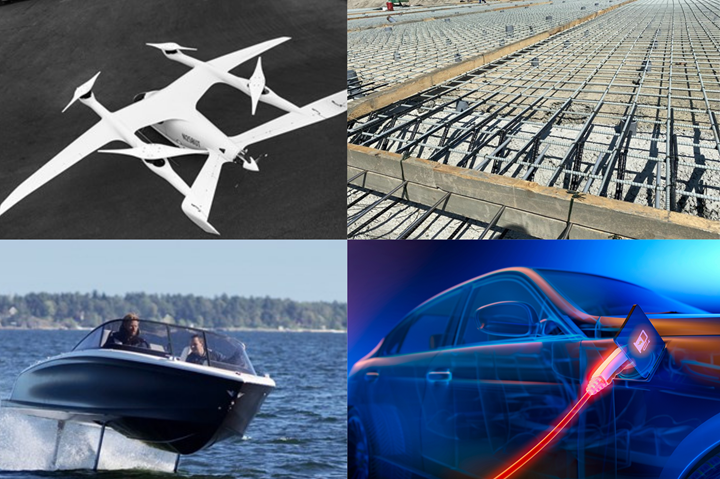The end is in sight for COVID-19: What comes next for the composites industry?
While the industry returns to some semblance of normality, a pre-pandemic “business as usual” does not seem likely. Dale Brosius ponders some of the questions that need to be faced.

Photo Credit: Beta Technologies (top left), Candela Boats (bottom left), Mateenbar (top right), Getty Images (bottom right).
Fourteen months ago, I wrote about the novel coronavirus and the impact it was already having on the composites marketplace, specifically, and life in general. At the time I wrote that column, about a month into the pandemic, the industry hoped COVID-19 would just be a short blip, with business as usual within a few months. As time went on and cases increased worldwide, it became obvious the only route back to “normal” would rely on the development and administration of COVID-19 vaccines.
Fortunately, vaccines have been developed and have proven to be highly effective in preventing the infection and spread of COVID-19. At the end of May 2021, roughly half the U.S. population 12 and older had been fully vaccinated and almost 60% had received at least one dose. Cases have fallen dramatically, and large numbers of people have resumed outdoor and indoor activities. Over the U.S. Memorial Day weekend at the end of May, U.S. airports processed almost two million travelers per day, roughly the same as were flying prior to the pandemic. Over the same weekend, 135,000 spectators were at the Indianapolis 500 auto race, capped at 40% of the 340,000 capacity for the track. Nonetheless, it was the largest crowd at a single event during the pandemic.
With many countries moving quickly with vaccinations, it’s tempting to declare victory over this coronavirus. However, there is still a long way to go before the world reaches herd immunity, and even then, there is the chance future variants may yet elude existing vaccines. It does look like the end is in sight, but a return to normal will look much different than “business as usual” pre-pandemic. So much has changed in the past 15 months that, for every answer, there seem to be even more questions.
As mentioned above, air travel, especially among tourists, is showing a robust recovery, with international routes expected to open over the course of the summer months in the northern hemisphere. But is this enough to spur airlines to release holds on aircraft orders? Or will we have to wait until September, when tourism ebbs, to see if business travel comes back strong? During 2020, recreational vehicles and boats set records for sales, as consumers changed how they spent time on vacations. Both are large markets for composite materials, but will these two sectors maintain higher-than-average levels of production?
It does look like the end is in sight, but a return to normal will look much different than “business as usual” pre-pandemic.
During the pandemic, a true transformation has taken place in the automotive market, as I wrote in January. While internal combustion engines (ICEs) still dominate today’s powertrains, electric vehicles (EVs) are clearly the future, based on country mandates and automaker investments. What will be the clear applications for composites in such vehicles, especially as batteries become cheaper and increase in density? Will weight savings remain important? While the commercial aircraft market went to the back burner, interest (and investment) in advanced air mobility (AAM), including flying cars and delivery vehicles, has zoomed to new heights. Most of these vehicles are expected to be battery-powered and will rely on composites as an enabler.
Addressing climate change with green energy infrastructure, like wind, solar and hydrogen has accelerated during the pandemic as well, and this will have a very positive impact on the outlook for composite materials. We were even introduced to the idea that future commercial aircraft will run on liquid hydrogen, perhaps to be stored in cryogenic carbon fiber tanks. In terms of infrastructure, significant investment in U.S. roads, bridges and waterways are also being considered, with emphasis on resilient, long-lasting solutions as an integral part of any funding legislation. This provides a clear opportunity for composites, but can we finally capitalize on it?
Supply chain issues exposed by the pandemic are fueling legislation in many countries to increase investment in R&D for advanced technologies, including composites, with a focus on growing domestic production of materials, parts and assemblies and improving economic competitiveness. Workforce development will be a key component to growing production. The pandemic led to layoffs and retirements, and reduced opportunities for next-generation workers. How will we meet the demand for technicians, researchers and engineers to meet those needs?
Finally, after many months of interaction via Zoom, Teams and other virtual platforms, how will we engage going forward? While technical service representatives will need to make customer visits, will sales calls remain virtual or will they return in person? If it’s the former, does this make the large trade shows/conferences like JEC, CAMX and SAMPE even more important for meeting face-to-face? There are still a lot of questions, and I’m looking forward to being part of the answers!
Read Next
The hydrogen economy: Hope or hype?
Green hydrogen technologies have become the forefront for the global zero-carbon energy landscape. Now, it may be cost that ultimately determines its expansion opportunities into the composites industry.
Read MoreAerospace: R&D investment now is critical to post-pandemic growth
While reduced R&D investments may be a natural response to the pandemic’s swift and brutal impact to commercial aviation, ramping up innovation is more imperative for the long-term.
Read MorePlant tour: Daher Shap’in TechCenter and composites production plant, Saint-Aignan-de-Grandlieu, France
Co-located R&D and production advance OOA thermosets, thermoplastics, welding, recycling and digital technologies for faster processing and certification of lighter, more sustainable composites.
Read More

















